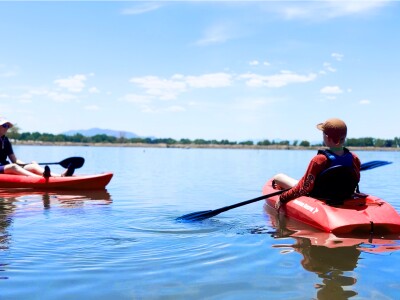Research goes into making a perfect football field
Hopkins & the field team:
Professor Hopkins consults with BYU Grounds and BYU Football to improve the field’s performance. The team is led by Jon Quist, manager of the football field, his supervisor Jim Gish, and director of BYU Grounds, Glenl Wear. Says Hopkins: “I am in charge of the research, but we all work together. What makes us special is the fantastic relationship we have between us scientists, our students and the grounds team that gets the job done."
In last year’s football game against Texas, fans were thrilled as BYU ran over, around and through Longhorn defenders to pile up 550 rushing yards in a record-setting victory.
Bryan Hopkins, a BYU professor of landscape management, was thrilled for another reason: He watched the natural grass surface at LaVell Edwards Stadium perform remarkably well after a two-hour, game-delaying monsoon drenched the field.
“It drained just like it was supposed to,” said Hopkins, the researcher behind making BYU’s field capable of withstanding 300-pound stomping linemen, while also making it look beautiful. “As any fan watching could tell, it certainly didn’t slow the players down. Especially BYU’s players.”
That’s exactly why Hopkins and his team geek out over grass—to make sure BYU and their opponents can perform on the field. But it wasn’t always this way—Hopkins mostly researched agricultural foods such as potatoes, corn and beans until he got a phone call from Bronco Mendenhall in 2008.
“Bronco’s call began the process of me switching over to working mostly with turf grass,” Hopkins said. “I had worked loosely with BYU grounds on various project before then, but the real involvement came after his call.”
Since then, Hopkins’ research has identified the proper amounts of nutrients to feed the grass to keep it healthy, as well as the right amount of water to keep it soft but not oversaturated. Some of his recent research focuses on the development of enhanced-efficiency fertilizers that results in deeper and thicker roots that provide a safer, greener and better playing surface with half the amount of fertilizer.
Inside his blindingly-bright lab in the Life Sciences Building, Hopkins tests grass care methods on tiny patches of turf nourished by nutrient-filled water buckets. Hydroponics, as it’s called, allows him and his student researchers to test different nutrients on dozens of grass patches to produce optimal results. The best methods eventually make their way into academic journals (like a study this week in the Journal of Plant Nutrition) and, ultimately, to BYU’s football field.
“BYU has, in my opinion, one of the top fields in the world,” said Hopkins, who regularly gathers data on all aspects of BYU’s playing surface to ensure it meets high standards. “And that pays dividends for our athletes in terms of safety and performance. For example, it performed to perfection in our first (2014) game against Houston.”
How perfectly? In his Houston post-game turf examination (he walks the field after most games), Hopkins couldn’t find a single divot: “I’ve never seen a Kentucky bluegrass with zero divots after a game!” he said.
Of course, BYU also played exceptionally well this year on Texas’ artificial turf field. Which brings up the question: Which is better? Turf or real grass? In Hopkins’ eyes there’s no question: the real stuff is the best.
“Artificial turf is much much better today than it was when I was playing football, which was essentially carpet on top of concrete,” Hopkins said. “It’s easier to use artificial turf, but real grass is a safer surface.”
And cooler. According to measurements, artificial turf can be as hot as 196 degrees at the surface level. The hottest natural grass will ever reach is 120 degrees.






